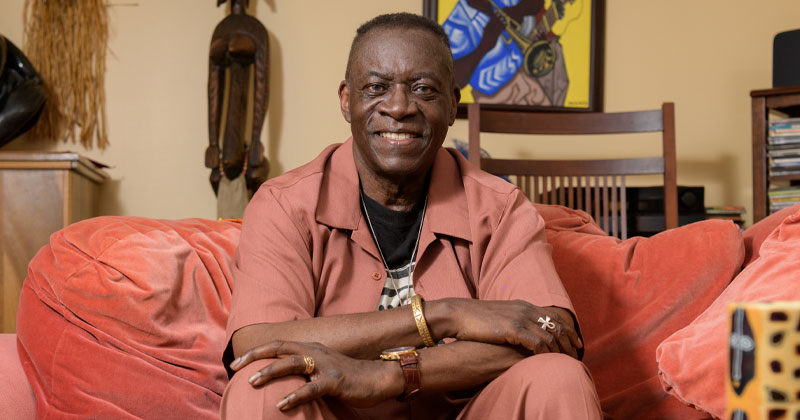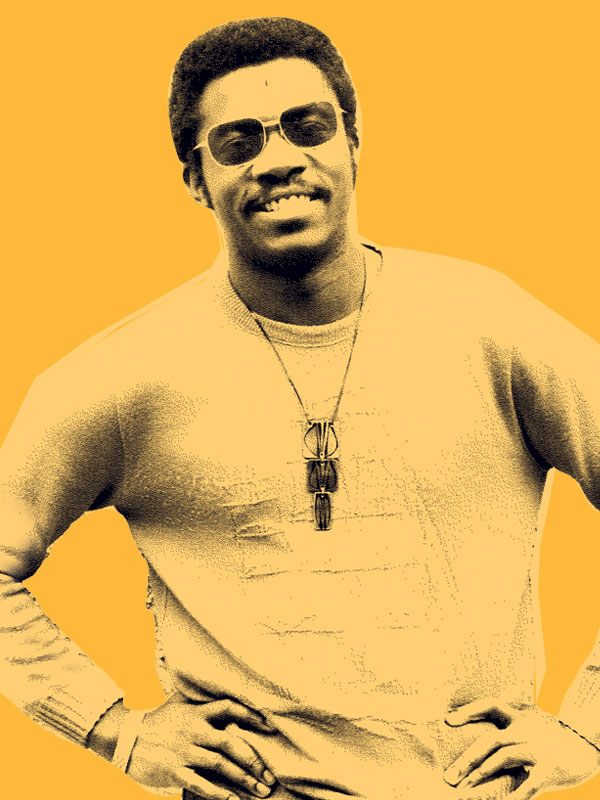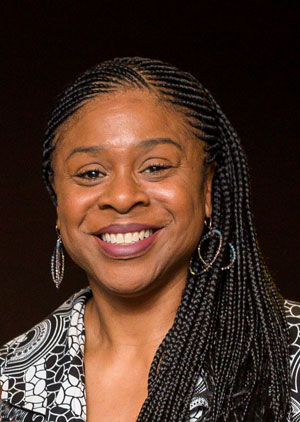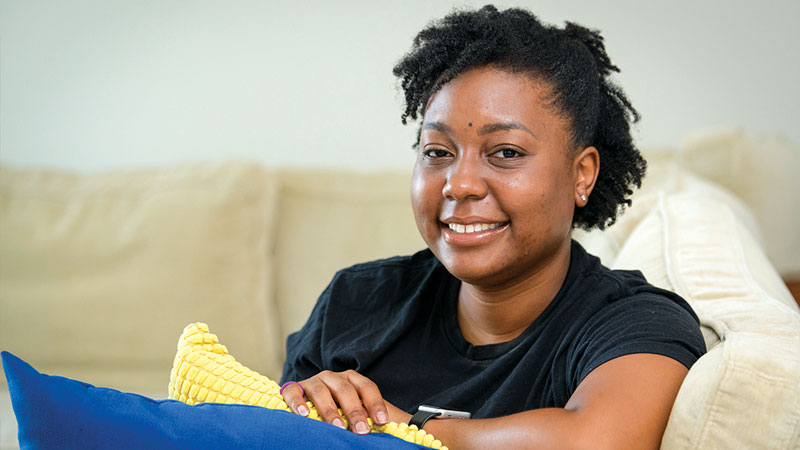


Our Shared Humanity
October 12, 2020
As the nation confronts its deep history of racial injustice, the University of Delaware must also reckon with its ghosts. From 1743-1950, Black students were prohibited from even applying to our institution. Now, at this inflection point in our nation’s history, we can no longer ignore racism’s deep and lasting legacy.
A University that proclaims a sacred duty to humanity by expanding knowledge simply must embrace all of humanity in that quest. When discrimination endures here, its shadows fall far beyond, denying the dreams of others and diminishing the greater good of a society in need of our collective talents and contributions.
This story will not magically change the Black student experience. It cannot even begin to capture the complexity and depth of that experience. At best, it may open a few eyes. At its most hopeful, it may open a few more hearts. For we often fail to see the things that don’t affect us. And what’s a year like 2020 if not to see more clearly?
Alvin Turner would have made a great journalist. He asked powerful people difficult questions and found the right story.
As a college student during the height of the Vietnam war, he spoke to the director of Selective Services. “How can you send boys to die?” he asked, and the man in charge of Delaware’s draft began to cry. His own son was fighting in Vietnam.
How can you capture a person’s essence in a newspaper article, Turner wondered? It seemed you either had to present someone as angelic or demonic, and people were more complicated than that. He was more complicated.
But we’re often viewed in one-dimension, he knew. Good or bad. Right or wrong. Black or white. The world sees what it wants.
As one of the first Black students at the University of Delaware in 1962, Alvin Turner understood how the world saw him. He had once forgotten his book in class, only to find it covered in notes that read, “N****r, go home.” There was a professor who would begin class by telling students to “take your lily-white fingers and open to page…” and another who assessed surnames by ethnicity—Irish, Italian, German—but said nothing after spotting Turner’s face.
For Turner and other students of color, the broad and long-ranging college experience in this country can be a painful reminder of what it means to be seen by unkind or indifferent eyes.
Turner, AS66, never became a journalist. A professor told him that he’d have a tough time finding a job, so he earned a master’s degree in rehabilitation counseling and doctorate in counseling psychology instead.
In 1973, he returned to UD, this time joining the staff to work with African-American students. These students all had strong academic skills, but not always the “attitudinal” ones: the ability to navigate an inhospitable culture; the courage to stand up to bad behavior; the safety to openly speak their truths; and the support to know that “this is your place, too.”
Inclusion matters, in both the hallowed halls of higher education, and in a world that often looks on in amused contempt and pity.
This year alone, “Black people have not only watched their friends and family members die at higher rates from the coronavirus, they have also watched people who look like them be gunned down while going for a jog, be murdered in their homes, threatened while bird watching, and mercilessly choked on camera,” Danielle Cadet, managing editor of Refinery29, wrote in a widely shared essay, “Your Black colleagues may look like they’re okay—chances are, they’re not.”
For some, that anguish exploded into anger and riots, “the language of the unheard,” as Martin Luther King Jr. explained. Or as Malcolm Gladwell wrote decades later, “The people who are asked to obey authority have to feel like they have a voice—that if they speak up, they will be heard.”
THE STORIES YOU DON'T HEAR
Turner’s experiences aren’t unique to the 1960s. Through the years, Black alumni have borne countless stories of being seen by unkind or indifferent eyes. Two of those stories happened not long ago.

Eryn Smith, EHD05, recalls being one of only two Black students in her education methods class. When students were told to pair into groups, she and her colleague made the conscious decision not to choose one another. “But at the end, we were the only ones left without a partner.”
More than a decade later, Rahkim Clark had a similar experience.
Clark entered UD as a STEM major in 2016 and scored high on the math placement exam, but his groupwork seemed to be uniquely scrutinized. “Let me just double check it,” his classmates would say to him, and him alone. In group presentations, fellow students asked him to give the quick introduction while his colleagues took on more substantive research topics. “Chemistry is the only class where I didn’t feel singled out,” he says, “because everybody was struggling.”
Clark, AS20, eventually changed his major to Africana studies, leaving a career in the sciences—where Blacks and Hispanics make up only 16% of those employed—before it even began.
Such microaggressions are common among Black students at predominantly White institutions, says Kasandra Moye, who offers more examples: Hearing or being called the N word. “Code switching,” or changing your language or expression depending on the audience. Experiencing double consciousness, exclusion and isolation.

BELONGING
As director of UD’s Center for Black Culture (CBC), Moye continues a legacy that began with Turner, Richard “Dickie” Wilson (p. 47), and many others who have helped shoulder the weight of the Black student experience.
“If I didn’t have the Center for Black Culture, I probably wouldn’t have gone out as much,” Keri Edwards, AS21, told fellow students at a packed Black Student Union town hall earlier this year.
At the same town hall, Kasiyah Tatem, AS22, spoke of being one of only two Black women in her comparative politics class; one of 15 students of color in a criminal justice class of 130; and one of seven Black students (of 40) in her student group.
“Forming study groups can be difficult because I feel little connection with my peers, and I feel isolated,” Tatem added. “Some people argue, this is just like the real world. But if UD becomes more diverse and inclusive, we can start a chain reaction across the nation.”
That is indeed the very mission of the CBC, and more broadly, of UD itself: for students to grow and give, gaining knowledge that will strengthen their lives and improve our world.
“The greatest myth is that the work we do [at the CBC] is somehow siloed and supports self-segregation,” says Moye. “No, it’s called belonging. It’s about connecting students to community in ways that validate their identity so that they connect beyond the center.”
In a perfect world, she envisions the CBC as a model for greater multicultural initiatives and efforts across the University, a sort of a prototype for inclusion: how to inspire healthy identity, encourage resilience and help all underrepresented groups feel welcome.
“If we had more resources, we could do more for students,” she says.
REACHING TOWARD CHANGE
The University wants to do more and has already made some progress.
Enrollment of historically underrepresented minority groups has risen 10% among undergraduate students and 27% among graduate students since 2016. Specifically, the number of Black undergraduates is up about 4% and the number of Black graduate students is up 12% during that same period.
Diversity modules have been added to the first-year curricula, and investments have been made to engage students with activities and programs that foster an inclusive environment. Black students can take part in programs that pair them with mentors, receive support breaking into certain fields, and have access to additional resources and networks.
Still, the University recognizes greater effort is needed.
On the eve of Juneteenth, the annual holiday commemorating slavery’s end in America, President Dennis Assanis outlined action items for the University, including: mandated diversity training for all faculty, staff and students, revamped faculty and staff searches, a thorough and historic review of naming considerations for buildings, new fundraising opportunities for social justice initiatives and more.
“We know numbers are just one component of the equation,” Assanis continued. “We must work ever harder to promote a more inclusive culture throughout UD where everyone is valued and all can expand their potential and believe in a better future.”
After all, change—in a college, in a country, in the confines of one’s own heart and home—requires action, investment and intent.
ESCAPING THE COMFORT ZONE
But newfound determination can be awkward and uncomfortable.
When Eryn Smith looks back on her college experience, she recalls another education classmate who was “so intentional about being my friend.” Allison would ask questions about Smith’s hair (“How often do you wash it?”) and lunch choices (“Do you eat this?” “Yes, it’s food.”).
“I would tell her, ‘I’ll answer this for you, but you really should not ask another Black person this,” Smith says now. “But today, she teaches English as a Second Language, and she’s worked in some of the most diverse school districts in the country.”

Allison did what others often don’t. Or won’t. She escaped her comfort zone.
At the Black Student Union town hall earlier this year, Abdul Musa, AS22, encouraged his peers to do the same.
“When you’re uncomfortable, you’re growing,” he said. “There are different opportunities that exist [on campus], but you have to look for them.”
And that’s just what Musa did. Through the Horn Entrepreneurship program, he established a healthcare venture and received funding to attend the Clinton Global Initiative in Scotland and to represent UD at the Elon Innovation Challenge in North Carolina.
“It’s been a rollercoaster,” he said of his college experience. “Up and down, we keep pushing.”
OPENING OUR EYES
The push to a more inclusive future continues, though the challenges are not new. In fact, the late UD sociology professor Frank Scarpitti listed many in a seminal 1969 report on “The Black Student and the University of Delaware.”
Known widely as the Scarpitti Report, the document outlined policies to increase recruitment and support for minority students and faculty at a time when Black students made up less than 1% of the undergraduate student body.
“A large proportion of the dominant white majority in this country is accustomed to interacting with Negroes only in the context of stereotyped role relationships,” he wrote in 1969. “These relationships, moreover, usually cast the Negro in menial or inferior positions. Members of the University of Delaware are no exception to this rule.”
Though Eryn Smith cringes at the language, she agrees with the overarching message.
“White people need more open and honest conversations with people of color,” she says. “Most of their impressions of Black people come from White people, and overwhelmingly, from White men.”
It’s a skewed perception that hurts both the observer and the observed.
Alvin Turner learned that from his track coach, Jimmy Flynn, who said, “You run slower when you run with someone you think is faster than you.”
And in that moment, Turner understood. Perception is not reality. But change one, and you can change the other.
In his five decades as a psychologist, Turner has used the principles of African psychology—the study of the impact and power of relationships, the search for collective identity and the quest to improve the human condition—to make sense of the senseless. He has counseled people who have raped and murdered; people who have been raped or have lost family members to murder. He has even used it to understand the traumas of his own college experience.
“It’s not that you don’t need to feel pain,” he says. “You need to learn from it, grow from it, and use it to help others.” Turner calls it a “search for our shared humanity.”
“It informs me what it means to be human,” he says. “If I can understand what it’s like to be you, I can see reality as you experience and understand it.”
Contact Us
Have a UDaily story idea?
Contact us at ocm@udel.edu
Members of the press
Contact us at 302-831-NEWS or visit the Media Relations website


